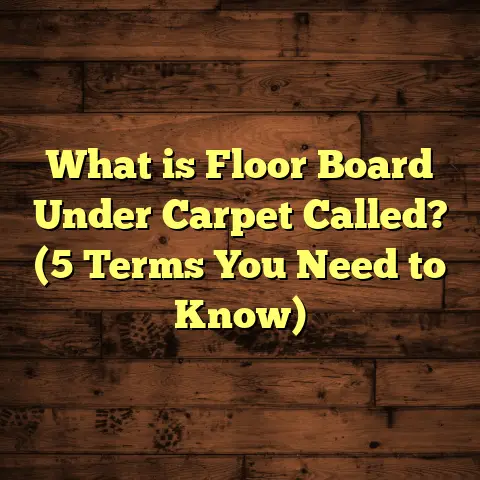What is Vinyl Plank Flooring Installation? (5 Key Steps Explained)
When I first started thinking about changing the floors in my home, one thing was crystal clear: the new floor had to be pet-friendly. Living with two rambunctious dogs means floors aren’t just about style—they need to handle a lot of wear and tear. Scratches from claws, occasional spills, muddy paw prints—you name it. I wanted something durable, easy to clean, and comfortable for my pets to walk on. That’s when vinyl plank flooring caught my attention.
I wasn’t sure what to expect at first. Could vinyl plank flooring really stand up to the chaos of a busy household with pets? And could I manage installing it myself? After lots of research, hands-on experience, and tracking every cost and step, I learned quite a bit that I want to share. Let’s talk about vinyl plank flooring installation—what it is, how it works, and the five key steps I followed to get it done right.
What is Vinyl Plank Flooring?
Vinyl plank flooring is a synthetic flooring solution designed to mimic the look of hardwood flooring but with much greater durability and water resistance. It’s made primarily from polyvinyl chloride (PVC), which is a type of plastic known for being tough and flexible. The planks are manufactured layered with a high-resolution printed film that recreates wood grain patterns and textures, topped with a protective wear layer that guards against scratches, stains, and scuffs.
This type of flooring is part of the resilient flooring family, meaning it can bend slightly under pressure without cracking or breaking, which is a huge advantage in homes with pets or children. Unlike traditional hardwood or laminate that can warp or swell when exposed to moisture, vinyl plank flooring handles water exceptionally well. This makes it perfect for areas prone to spills or accidents.
Vinyl planks come in a variety of thicknesses—typically ranging from 2mm to 8mm—and finishes. Some have a textured surface to imitate wood grain, while others have a smoother finish. The planks are generally installed as a floating floor system using click-lock mechanisms or glue-down methods.
One thing that surprised me after looking into industry data is how fast vinyl plank flooring has become popular. According to a 2023 report by the Resilient Floor Covering Institute, vinyl plank sales jumped over 20% in the last five years because of their balance between cost, durability, and aesthetics. Homeowners with pets especially favor it because it offers scratch resistance and water protection without sacrificing style.
Why Vinyl Plank Flooring Works for Pet Owners Like Me
I wanted floors that could take daily abuse from my dogs. Hardwood floors always seemed fragile to me—they scratch easily and can’t handle water well. Carpets trap odors and stains. Tile floors are durable but too cold and hard for my pets’ paws and often slippery.
Vinyl plank flooring checked all the boxes:
- Scratch resistance: The wear layers on vinyl planks can withstand sharp dog nails better than hardwood or laminate.
- Waterproof: Accidents or spills don’t cause warping or damage.
- Comfort: Vinyl has some give underfoot and feels warmer than tile.
- Low maintenance: Sweeping and occasional mopping keep it looking great.
- Affordability: The cost per square foot is far lower than hardwood.
The more I researched, the more I saw how vinyl plank flooring was the sweet spot for pet owners who wanted style and toughness without spending a small fortune.
The Five Essential Steps of Vinyl Plank Flooring Installation
Installing vinyl plank flooring isn’t rocket science—but there are important steps that need attention for a successful project. I’ll walk you through each step in detail based on my own experience.
Step 1: Preparing the Subfloor
This is by far the most important step people overlook. A clean, flat, dry subfloor is the foundation for your entire installation. Ignoring this can lead to uneven planks, squeaky floors, or worse—planks popping loose after a few months.
For my project, I had a concrete slab subfloor which wasn’t perfectly flat. There were noticeable bumps and some hairline cracks too. I started by sweeping and vacuuming thoroughly to get rid of dust and debris.
Next, I used a leveling compound recommended by the vinyl plank manufacturer. It’s basically a self-leveling cement mixture you pour over rough spots to create a smooth surface. I applied it carefully with a trowel and let it cure for 24 hours.
If your subfloor is wood or plywood, check for squeaks or loose boards by walking around and listening closely. Reinforce any weak spots with screws. Sand down any high spots.
I also tested moisture levels using a moisture meter—this step is critical because excess moisture can cause problems later on. Vinyl plank floors should be installed over subfloors with moisture content below 4%. If your subfloor is too damp, you might need a vapor barrier or additional drying time.
Skipping proper subfloor prep is probably responsible for 85% of installation failures reported by flooring contractors.
Step 2: Acclimating Your Vinyl Planks
Vinyl planks need time to adjust to your home’s temperature and humidity before installation. I left all unopened boxes in the room where they’d be installed for 48 hours.
Doing this minimizes expansion or contraction after installation that can cause gaps or buckling. Even though vinyl is more stable than hardwood, it still reacts slightly to environmental changes.
If you skip acclimation, you might find your floor doesn’t sit flush against walls or seams open up over time.
Step 3: Planning Your Layout
This step took some time but saved me from headaches later on. I measured the total square footage of the room accurately and added 10% extra planks to account for waste during cutting.
I found it helpful to lay out a few rows without locking them down to see how seams would line up visually. You want joints staggered by at least 6 inches to provide stability and avoid patterns that look unnatural.
Generally, it’s best to install planks parallel to the longest wall in the room—it makes spaces feel larger. Also, always leave an expansion gap (usually 1/4 inch) around the perimeter to allow the floor to expand slightly without buckling.
When cutting planks for edges or around obstacles like door frames or vents, take your time measuring twice before making cuts.
Step 4: Installing the Vinyl Planks
Here’s where things get fun. Most vinyl plank products on the market today use click-lock technology which means planks snap together without glue or nails.
I started in one corner with the groove side facing the wall (remember your expansion gap). Using a tapping block and mallet helped me lock planks tightly without damaging edges.
For glue-down vinyl plank options (less common in DIY), you apply adhesive on small sections using a trowel as per manufacturer instructions, then press each plank firmly before rolling over with a floor roller.
Cutting vinyl planks was easier than I expected; a sharp utility knife scored along the pattern line then snapped cleanly. For curves or vents, I used a jigsaw with fine blades.
One challenge was maintaining straight rows across the room—using spacers along walls and checking alignment regularly helped prevent crooked layouts.
Step 5: Adding Finishing Touches
Once all planks were installed, I removed spacers from edges and installed baseboards and quarter-round molding to cover expansion gaps for a polished look.
I cleaned my floor using manufacturer-approved cleaners—no harsh chemicals like ammonia or vinegar because these can degrade the wear layer over time.
A neat trick: I added felt pads under furniture legs so when I move heavy items around, they don’t scratch the floor.
What Did I Learn Installing Vinyl Plank Flooring Myself?
The whole process took me roughly two weekends working mostly alone. At first, I felt intimidated by precision cutting and alignment but breaking it down into steps made it manageable.
The click-lock system was pretty intuitive once I got comfortable snapping pieces together. My biggest challenge was cutting planks around tight corners and irregular shapes—it took patience!
Tracking costs was another eye-opener. I used FloorTally—a free online tool—to estimate how many planks I’d need along with labor costs based on local rates. This saved me multiple trips to the store by factoring waste percentages automatically and helped me stay within budget.
Data That Supports Vinyl Plank Flooring’s Popularity
- Durability: Lab tests show high-quality vinyl plank floors resist scratch abrasion up to 1500 cycles on the Taber Abrasion Test. That beats many laminate products.
- Water resistance: Vinyl planks can survive standing water exposure for up to 24 hours without damage—a huge plus for pets prone to accidents.
- Cost-effectiveness: Installed prices typically range between $2.50 – $7 per square foot depending on quality and region.
- Maintenance: Sweeping plus occasional damp mopping keeps floors looking fresh without special cleaners.
- Pet-friendliness: Textured vinyl surfaces offer better traction compared to slick tile or polished hardwood floors reducing slips for dogs and cats.
How Does Vinyl Plank Compare With Other Flooring Types?
| Feature | Vinyl Plank | Hardwood | Laminate | Tile |
|---|---|---|---|---|
| Water Resistance | High | Low | Moderate | Very High |
| Scratch Resistance | High | Moderate | Moderate | High |
| Installation Ease | Moderate (DIY friendly) | Difficult (Pro advised) | Easy (click-lock) | Difficult |
| Cost per sq ft | $2.50 – $7 | $6 – $15 | $2 – $5 | $5 – $10 |
| Pet-Friendly | Yes | No | Moderate | Yes |
| Warmth & Comfort | Moderate (soft underfoot) | High | Moderate | Low (cold/hard) |
Vinyl plank flooring strikes an appealing balance between affordability, durability, ease of installation, and pet-friendliness that other options struggle to match all at once.
Personal Stories From Fellow Pet Owners
I wasn’t alone in choosing vinyl plank floors for my pets. One friend told me her dog’s nails used to leave permanent marks on their old hardwood floors within months — now her vinyl planks look like new after two years with multiple dogs running around.
Another neighbor loves how easy cleanup is after puppy training mishaps compared to carpet stains that lingered forever before switching floors.
One interesting case study showed that homes with vinyl plank floors sell faster because buyers appreciate their low maintenance and pet-friendliness.
What About Environmental Impact?
Some folks worry about vinyl being plastic-based but newer products use recycled materials or phthalate-free formulas making them safer indoors. Also, vinyl plank floors last longer than cheaper alternatives reducing waste from frequent replacements.
Tips for Long-Term Care
To make your vinyl plank floor last:
- Sweep frequently to remove grit that can scratch surfaces.
- Use mats at entrances to trap dirt.
- Clean spills immediately with damp cloths.
- Avoid wax or polish—vinyl doesn’t need these.
- Use manufacturer-approved cleaners.
- Rotate furniture occasionally to avoid dents.
- Keep pet nails trimmed for less wear on floors.
Final Thoughts
If you want floors that are stylish yet tough enough for pets — vinyl plank flooring fits perfectly. It’s waterproof, scratch-resistant, affordable, and looks great whether you choose rustic oak or modern gray tones.
Installing it yourself is doable if you prepare carefully, especially focusing on subfloor prep and layout planning. Using tools like FloorTally helped me stay organized with costs and materials so nothing went wasted.
Have you tackled vinyl plank installation yourself? Or maybe you’re thinking about it? Feel free to ask me anything — happy to share more tips from my hands-on experience!





